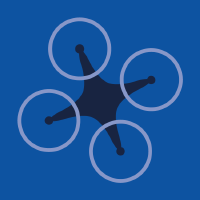Topic Menu
► Topic MenuTopic Editors



Autonomy for Enabling the Next Generation of UAVs
Topic Information
Dear Colleagues,
UAVs have been a center of interest for more than a decade now. Despite it being commonly accepted that the benefits of their broad utilization are vastly significant and span across all of the application sectors, still there are sizeable challenges to overcome—i.e., those related to their resilience in operating autonomously in harsh, varying, and unknown environments.
Thus, the current topic aims to collect multiple novel contributions in the field of resilient autonomy for UAVs with characteristic examples targeting, but not limited to, UAV areas of research in:
- Automatic control;
- Local and global path planning;
- Mission generation;
- Multi-vehicle orchestration schemes;
- Perception;
- Multi-sensorial fusion;
- UAV applications;
- UAV-based multi-session SLAM;
- UAV novel concept design;
- UAV-based remote sensing;
- UAV and human interaction;
- UAV-based aerial manipulation.
Prof. Dr. George Nikolakopoulos
Prof. Dr. Pablo Rodríguez-Gonzálvez
Prof. Dr. Diego González-Aguilera
Topic Editors
Keywords
- automatic control
- local and Global Path planning
- mission generation
- multi-vehicle orchestration schemes
- perception
- multi-sensorial fusion
- UAV applications
- UAV based multi-session
- SLAM
- UAV novel concept designs
- UAV based remote sensing
- UAV and human interaction
- UAV based aerial manipulation
Participating Journals
| Journal Name | Impact Factor | CiteScore | Launched Year | First Decision (median) | APC |
|---|---|---|---|---|---|

Applied Sciences
|
2.7 | 4.5 | 2011 | 16.9 Days | CHF 2400 |

Remote Sensing
|
5.0 | 7.9 | 2009 | 23 Days | CHF 2700 |

Drones
|
4.8 | 6.1 | 2017 | 17.9 Days | CHF 2600 |

Sensors
|
3.9 | 6.8 | 2001 | 17 Days | CHF 2600 |

MDPI Topics is cooperating with Preprints.org and has built a direct connection between MDPI journals and Preprints.org. Authors are encouraged to enjoy the benefits by posting a preprint at Preprints.org prior to publication:
- Immediately share your ideas ahead of publication and establish your research priority;
- Protect your idea from being stolen with this time-stamped preprint article;
- Enhance the exposure and impact of your research;
- Receive feedback from your peers in advance;
- Have it indexed in Web of Science (Preprint Citation Index), Google Scholar, Crossref, SHARE, PrePubMed, Scilit and Europe PMC.

